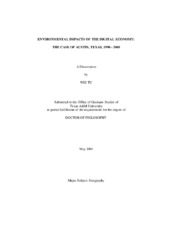| dc.description.abstract | This dissertation investigates the dynamic economic structure transformation and its corresponding environmental consequences at the Austin-San Marcos Metropolitan Statistical Area (Austin MSA) from 1990 to 2008. Input-output (IO) analysis is the major methodology and environmental problems are defined as emissions of industrial point air pollutants. Both three-and seven-segment IO models of Austin MSA for the years of 1990, 1994, and 1999 are constructed. Direct and total pollution coefficients of six major pollutants are calculated, hypothe tical extraction measurement and structural decomposition analysis are implemented, and the quantity and pattern of pollutant emissions are simulated based on four major assumed development scenarios from 2000 to 2008.
This study finds: 1) the digital economy has emerged in the Austin MSA during the 1990s, 2) the manufacturing process of Austin MSA tended to be more environmentally friendly, which supports the hypothesis of dematerialization and decarbonization, 3) consumption-driven and non-production segments related environmental problems becomes more significant in the emerging digital economy.
This study predicts that industrial point air pollutant emissions will grow moderately from 2000 to 2008, assuming that the direct pollutant coefficients will change at the average rates of the 1990s and the final demand will grow at the half rates of the 1990s?? average. Pollution contribution from production segment will generally decrease and contribution from other segments such as ICT and Information will increase, however, emission contributions of the segments will vary in terms of pollutants as well as development scenarios.
This study argues that the shift of the source and nature of environmental threats of in the digital economy mandates parallel reform of the current environmental policy. A new generation of policy should be cooperative rather than confrontational, integrated rather than fragmented, flexible rather than rigid. It should also facilitate innovative management initiatives to achieve sustainability. More fundamentally, it is expected to deal with environmental impacts of intangible information flows (bits) which are possibly more essential than flows of tangible goods and services (atoms) in the context of the digital economy and the information age. | en |


